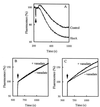Hop resistance in the beer spoilage bacterium Lactobacillus brevis is mediated by the ATP-binding cassette multidrug transporter HorA
- PMID: 11514522
- PMCID: PMC95421
- DOI: 10.1128/JB.183.18.5371-5375.2001
Hop resistance in the beer spoilage bacterium Lactobacillus brevis is mediated by the ATP-binding cassette multidrug transporter HorA
Abstract
Lactobacillus brevis is a major contaminant of spoiled beer. The organism can grow in beer in spite of the presence of antibacterial hop compounds that give the beer a bitter taste. The hop resistance in L. brevis is, at least in part, dependent on the expression of the horA gene. The deduced amino acid sequence of HorA is 53% identical to that of LmrA, an ATP-binding cassette multidrug transporter in Lactococcus lactis. To study the role of HorA in hop resistance, HorA was functionally expressed in L. lactis as a hexa-histidine-tagged protein using the nisin-controlled gene expression system. HorA expression increased the resistance of L. lactis to hop compounds and cytotoxic drugs. Drug transport studies with L. lactis cells and membrane vesicles and with proteoliposomes containing purified HorA protein identified HorA as a new member of the ABC family of multidrug transporters.
Figures






Similar articles
-
Beer spoilage bacteria and hop resistance.Int J Food Microbiol. 2003 Dec 31;89(2-3):105-24. doi: 10.1016/s0168-1605(03)00153-3. Int J Food Microbiol. 2003. PMID: 14623377 Review.
-
Biochemical characterization of horA-independent hop resistance mechanism in Lactobacillus brevis.Int J Food Microbiol. 2002 Jun 25;76(3):223-30. doi: 10.1016/s0168-1605(02)00016-8. Int J Food Microbiol. 2002. PMID: 12051479
-
The purified and functionally reconstituted multidrug transporter LmrA of Lactococcus lactis mediates the transbilayer movement of specific fluorescent phospholipids.Biochemistry. 1999 Dec 7;38(49):16298-306. doi: 10.1021/bi990855s. Biochemistry. 1999. PMID: 10587454
-
A novel horA genetic mediated RCA detection of beer spoilage lactobacillus.Microb Pathog. 2018 Jan;114:311-314. doi: 10.1016/j.micpath.2017.11.064. Epub 2017 Nov 29. Microb Pathog. 2018. PMID: 29197525
-
Multidrug transporters and antibiotic resistance in Lactococcus lactis.Biochim Biophys Acta. 2002 Sep 10;1555(1-3):1-7. doi: 10.1016/s0005-2728(02)00246-3. Biochim Biophys Acta. 2002. PMID: 12206883 Review.
Cited by
-
The microbiology of malting and brewing.Microbiol Mol Biol Rev. 2013 Jun;77(2):157-72. doi: 10.1128/MMBR.00060-12. Microbiol Mol Biol Rev. 2013. PMID: 23699253 Free PMC article. Review.
-
Complete genome sequence of the beer spoilage organism Pediococcus claussenii ATCC BAA-344T.J Bacteriol. 2012 Mar;194(5):1271-2. doi: 10.1128/JB.06759-11. J Bacteriol. 2012. PMID: 22328764 Free PMC article.
-
Molecular cloning and functional characterization of an ATP-binding cassette transporter OtrC from Streptomyces rimosus.BMC Biotechnol. 2012 Aug 20;12:52. doi: 10.1186/1472-6750-12-52. BMC Biotechnol. 2012. PMID: 22906146 Free PMC article.
-
Proteomic approach for characterization of hop-inducible proteins in Lactobacillus brevis.Appl Environ Microbiol. 2007 May;73(10):3300-6. doi: 10.1128/AEM.00124-07. Epub 2007 Mar 16. Appl Environ Microbiol. 2007. PMID: 17369340 Free PMC article.
-
A Plasmid-Encoded Putative Glycosyltransferase Is Involved in Hop Tolerance and Beer Spoilage in Lactobacillus brevis.Appl Environ Microbiol. 2020 Jan 21;86(3):e02268-19. doi: 10.1128/AEM.02268-19. Print 2020 Jan 21. Appl Environ Microbiol. 2020. PMID: 31757821 Free PMC article.
References
-
- Davies J. Inactivation of antibiotics and the dissemination of resistance genes. Science. 1994;264:375–382. - PubMed
-
- Higgins C F. ABC transporters: from microorganisms to man. Annu Rev Cell Biol. 1992;8:67–113. - PubMed
-
- Margolles M, Putman M, van Veen H W, Konings W N. The purified and functionally reconstituted multidrug transporter LmrA of Lactococcus lactis mediates the transbilayer movement of specific fluorescent phospholipids. Biochemistry. 1999;38:16298–16306. - PubMed
Publication types
MeSH terms
Substances
LinkOut - more resources
Full Text Sources

